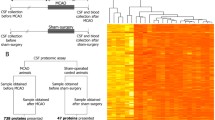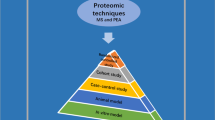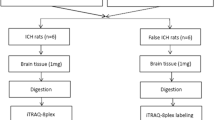Abstract
Ischemic stroke is a devastating neurological disease that can cause permanent brain damage, but to date, few biomarkers are available to reliably assess the severity of injury during acute onset. In this study, quantitative proteomic analysis of ischemic mouse brain detected the increase in expression levels of clusterin (CLU) and cystatin C (CST3). Since CLU is a secretary protein, serum samples (n = 70) were obtained from acute ischemic stroke (AIS) patients within 24 h of stroke onset and together with 70 matched health controls. Analysis of CLU levels indicated significantly higher levels in AIS patients than healthy controls (14.91 ± 4.03 vs. 12.79 ± 2.22 ng/L; P = 0.0004). Analysis of serum CST3 also showed significant increase in AIS patients as compared with healthy controls (0.90 ± 0.19 vs. 0.84 ± 0.12 ng/L; P = 0.0064). The serum values of CLU were also positively correlated with the NIH Stroke Scale (NIHSS) scores, the time interval after stroke onset, as well as major stroke risk factors associated with lipid profile. These data demonstrate that elevated levels of serum CLU and CST3 are independently associated with AIS and may serve as peripheral biomarkers to aid clinical assessment of AIS and its severity. This pilot study thus contributes to progress toward preclinical proteomic screening by using animal models and allows translation of results from bench to bedside.





Similar content being viewed by others
References
van der Worp HB, van Gijn J. Clinical practice. Acute ischemic stroke. N Engl J Med. 2007;357(6):572–9. https://doi.org/10.1056/NEJMcp072057.
Sacco RL, Kasner SE, Broderick JP, Caplan LR, Connors JJ, Culebras A, et al. An updated definition of stroke for the 21st century: a statement for healthcare professionals from the American Heart Association/American Stroke Association. Stroke. 2013;44(7):2064–89. https://doi.org/10.1161/STR.0b013e318296aeca.
Mozaffarian D, Benjamin EJ, Go AS, Arnett DK, Blaha MJ, Cushman M, et al. Heart disease and stroke statistics--2015 update: a report from the American Heart Association. Circulation. 2015;131(4):e29–322. https://doi.org/10.1161/CIR.0000000000000152.
Catanese L, Tarsia J, Fisher M. Acute ischemic stroke therapy overview. Circ Res. 2017;120(3):541–58. https://doi.org/10.1161/CIRCRESAHA.116.309278.
Whiteley W, Chong WL, Sengupta A, Sandercock P. Blood markers for the prognosis of ischemic stroke: a systematic review. Stroke. 2009;40(5):e380–9. https://doi.org/10.1161/STROKEAHA.108.528752.
Jickling GC, Sharp FR. Biomarker panels in ischemic stroke. Stroke. 2015;46(3):915–20. https://doi.org/10.1161/STROKEAHA.114.005604.
Maas MB, Furie KL. Molecular biomarkers in stroke diagnosis and prognosis. Biomark Med. 2009;3(4):363–83. https://doi.org/10.2217/bmm.09.30.
Carpenter KL, Czosnyka M, Jalloh I, Newcombe VF, Helmy A, Shannon RJ, et al. Systemic, local, and imaging biomarkers of brain injury: more needed, and better use of those already established? Front Neurol. 2015;6:26. https://doi.org/10.3389/fneur.2015.00026.
Lindsey ML, Mayr M, Gomes AV, Delles C, Arrell DK, Murphy AM, et al. Transformative impact of proteomics on cardiovascular health and disease: a scientific statement from the American Heart Association. Circulation. 2015;132(9):852–72. https://doi.org/10.1161/CIR.0000000000000226.
Ning M, Lo EH. Opportunities and challenges in omics. Transl Stroke Res. 2010;1(4):233–7. https://doi.org/10.1007/s12975-010-0048-y.
Ning M, Lopez M, Cao J, Buonanno FS, Lo EH. Application of proteomics to cerebrovascular disease. Electrophoresis. 2012;33(24):3582–97. https://doi.org/10.1002/elps.201200481.
Swan AL, Mobasheri A, Allaway D, Liddell S, Bacardit J. Application of machine learning to proteomics data: classification and biomarker identification in postgenomics biology. OMICS. 2013;17(12):595–610.
Zimmermann-Ivol CG, Burkhard PR, Le Floch-Rohr J, Allard L, Hochstrasser DF, Sanchez JC. Fatty acid binding protein as a serum marker for the early diagnosis of stroke: a pilot study. Mol Cell Proteomics. 2004;3(1):66–72. https://doi.org/10.1074/mcp.M300066-MCP200.
Ning M, Sarracino DA, Kho AT, Guo S, Lee SR, Krastins B, et al. Proteomic temporal profile of human brain endothelium after oxidative stress. Stroke. 2011;42(1):37–43. https://doi.org/10.1161/STROKEAHA.110.585703.
Garcia-Berrocoso T, Penalba A, Boada C, Giralt D, Cuadrado E, Colome N, et al. From brain to blood: new biomarkers for ischemic stroke prognosis. J Proteome. 2013;94:138–48. https://doi.org/10.1016/j.jprot.2013.09.005.
Ramsubramaniam N, Tao F, Li S, Marten MR. Cost-effective isobaric tagging for quantitative phosphoproteomics using DiART reagents. Mol BioSyst. 2013;9(12):2981–7. https://doi.org/10.1039/c3mb70358d.
Ramsubramaniam N, Tao F, Li S, Marten MR. Novel and cost-effective 6-plex isobaric tagging reagent, DiART, is effective for identification and relative quantification of complex protein mixtures using PQD fragmentation. J Mass Spectrom. 2013;48(9):1032–41. https://doi.org/10.1002/jms.3249.
Weinstein G, Beiser AS, Preis SR, Courchesne P, Chouraki V, Levy D, et al. Plasma clusterin levels and risk of dementia, Alzheimer’s disease, and stroke. Alzheimers Dement (Amst). 2016;3:103–9. https://doi.org/10.1016/j.dadm.2016.06.005.
Cevik O, Baykal AT, Sener A. Platelets proteomic profiles of acute ischemic stroke patients. PLoS One. 2016;11(6):e0158287. https://doi.org/10.1371/journal.pone.0158287.
Deming Y, Xia J, Cai Y, Lord J, Holmans P, Bertelsen S, et al. A potential endophenotype for Alzheimer’s disease: cerebrospinal fluid clusterin. Neurobiol Aging. 2016;37:208 e1–9. https://doi.org/10.1016/j.neurobiolaging.2015.09.009.
Coll E, Botey A, Alvarez L, Poch E, Quinto L, Saurina A, et al. Serum cystatin C as a new marker for noninvasive estimation of glomerular filtration rate and as a marker for early renal impairment. Am J Kidney Dis. 2000;36(1):29–34. https://doi.org/10.1053/ajkd.2000.8237.
Ni L, Lu J, Hou LB, Yan JT, Fan Q, Hui R, et al. Cystatin C, associated with hemorrhagic and ischemic stroke, is a strong predictor of the risk of cardiovascular events and death in Chinese. Stroke. 2007;38(12):3287–8. https://doi.org/10.1161/STROKEAHA.107.489625.
Fang Z, Deng J, Wu Z, Dong B, Wang S, Chen X, et al. Cystatin C is a crucial endogenous protective determinant against stroke. Stroke. 2017;48(2):436–44. https://doi.org/10.1161/STROKEAHA.116.014975.
Chuang DY, Cui J, Simonyi A, Engel VA, Chen S, Fritsche KL et al. Dietary Sutherlandia and elderberry mitigate cerebral ischemia-induced neuronal damage and attenuate p47phox and phospho-ERK1/2 expression in microglial cells. ASN Neuro. 2014;6(6). https://doi.org/10.1177/1759091414554946.
Johnson MC, Song H, Cui J, Mossine VV, Gu Z, Greenlief CM. Development of a method and validation for the quantitation of FruArg in mice plasma and brain tissue using UPLC–MS/MS. ACS Omega. 2016;1(4):663–8. https://doi.org/10.1021/acsomega.6b00220.
Qu Z, Meng F, Bomgarden RD, Viner RI, Li J, Rogers JC, et al. Proteomic quantification and site-mapping of S-nitrosylated proteins using isobaric iodoTMT reagents. J Proteome Res. 2014;13(7):3200–11. https://doi.org/10.1021/pr401179v.
Demaerschalk BM, Kleindorfer DO, Adeoye OM, Demchuk AM, Fugate JE, Grotta JC, et al. Scientific rationale for the inclusion and exclusion criteria for intravenous alteplase in acute ischemic stroke: a statement for healthcare professionals from the American Heart Association/American Stroke Association. Stroke. 2016;47(2):581–641.
Lyden PD, Lu M, Levine SR, Brott TG, Broderick J, Group NrSS. A modified National Institutes of Health Stroke Scale for use in stroke clinical trials: preliminary reliability and validity. Stroke. 2001;32(6):1310–7.
Miyake H, Muramaki M, Furukawa J, Kurahashi T, Fujisawa M. Serum level of clusterin and its density in men with prostate cancer as novel biomarkers reflecting disease extension. Urology. 2010;75(2):454–9. https://doi.org/10.1016/j.urology.2009.08.029.
Shimizu-Tokiwa A, Kobata M, Io H, Kobayashi N, Shou I, Funabiki K, et al. Serum cystatin C is a more sensitive marker of glomerular function than serum creatinine. Nephron. 2002;92(1):224–6.
Wang J, Jin H, Hua Y, Keep RF, Xi G. Role of protease-activated receptor-1 in brain injury after experimental global cerebral ischemia. Stroke. 2012;43(9):2476–82. https://doi.org/10.1161/STROKEAHA.112.661819.
Kristian T, Hu B. Guidelines for using mouse global cerebral ischemia models. Transl Stroke Res. 2013;4(3):343–50. https://doi.org/10.1007/s12975-012-0236-z.
Chen Z, Wang Q, Lin L, Tang Q, Edwards JL, Li S, et al. Comparative evaluation of two isobaric labeling tags, DiART and iTRAQ. Anal Chem. 2012;84(6):2908–15. https://doi.org/10.1021/ac203467q.
Song H, Lu Y, Qu Z, Mossine VV, Martin MB, Hou J, et al. Effects of aged garlic extract and FruArg on gene expression and signaling pathways in lipopolysaccharide-activated microglial cells. Sci Rep. 2016;6:35323. https://doi.org/10.1038/srep35323.
Cline MS, Smoot M, Cerami E, Kuchinsky A, Landys N, Workman C, et al. Integration of biological networks and gene expression data using Cytoscape. Nat Protoc. 2007;2(10):2366–82. https://doi.org/10.1038/nprot.2007.324.
Arrell DK, Terzic A. Network systems biology for drug discovery. Clin Pharmacol Ther. 2010;88(1):120–5. https://doi.org/10.1038/clpt.2010.91.
Jauch EC WK, Carrozzella J. Proteomic analyses demonstrates ultra-early elevations of inflammation-sensitive plasma proteins following ischemic stroke. 5th World Stroke Congress, Vancouver BC, Canada. 2004.
Jensen MB, Chacon MR, Sattin JA, Aleu A, Lyden PD. The promise and potential pitfalls of serum biomarkers for ischemic stroke and transient ischemic attack. Neurologist. 2008;14(4):243–6. https://doi.org/10.1097/NRL.0b013e31815a9945.
Chow SL, Maisel AS, Anand I, Bozkurt B, De Boer RA, Felker GM, et al. Role of biomarkers for the prevention, assessment, and management of heart failure: a scientific statement from the American Heart Association. Circulation. 2017;135(22):e1054–e91.
Zoubeidi A, Chi K, Gleave M. Targeting the cytoprotective chaperone, clusterin, for treatment of advanced cancer. Clin Cancer Res. 2010;16(4):1088–93. https://doi.org/10.1158/1078-0432.CCR-09-2917.
Imhof A, Charnay Y, Vallet PG, Aronow B, Kovari E, French LE, et al. Sustained astrocytic clusterin expression improves remodeling after brain ischemia. Neurobiol Dis. 2006;22(2):274–83. https://doi.org/10.1016/j.nbd.2005.11.009.
Desikan RS, Thompson WK, Holland D, Hess CP, Brewer JB, Zetterberg H, et al. The role of clusterin in amyloid-beta-associated neurodegeneration. JAMA Neurol. 2014;71(2):180–7. https://doi.org/10.1001/jamaneurol.2013.4560.
Santilli G, Aronow BJ, Sala A. Essential requirement of apolipoprotein J (clusterin) signaling for IkappaB expression and regulation of NF-kappaB activity. J Biol Chem. 2003;278(40):38214–9. https://doi.org/10.1074/jbc.C300252200.
Zhang H, Kim JK, Edwards CA, Xu Z, Taichman R, Wang CY. Clusterin inhibits apoptosis by interacting with activated Bax. Nat Cell Biol. 2005;7(9):909–15. https://doi.org/10.1038/ncb1291.
Wehrli P, Charnay Y, Vallet P, Zhu G, Harmony J, Aronow B, et al. Inhibition of post-ischemic brain injury by clusterin overexpression. Nat Med. 2001;7(9):977–9. https://doi.org/10.1038/nm0901-977.
Han BH, DeMattos RB, Dugan LL, Kim-Han JS, Brendza RP, Fryer JD, et al. Clusterin contributes to caspase-3-independent brain injury following neonatal hypoxia-ischemia. Nat Med. 2001;7(3):338–43. https://doi.org/10.1038/85487.
Kroksveen AC, Aasebo E, Vethe H, Van Pesch V, Franciotta D, Teunissen CE, et al. Discovery and initial verification of differentially abundant proteins between multiple sclerosis patients and controls using iTRAQ and SID-SRM. J Proteome. 2013;78:312–25. https://doi.org/10.1016/j.jprot.2012.09.037.
Tu C, Beharry KD, Shen X, Li J, Wang L, Aranda JV, et al. Proteomic profiling of the retinas in a neonatal rat model of oxygen-induced retinopathy with a reproducible ion-current-based MS1 approach. J Proteome Res. 2015;14(5):2109–20. https://doi.org/10.1021/pr501238m.
Turk V, Turk B, Guncar G, Turk D, Kos J. Lysosomal cathepsins: structure, role in antigen processing and presentation, and cancer. Adv Enzym Regul. 2002;42:285–303.
Yan S, Sloane BF. Molecular regulation of human cathepsin B: implication in pathologies. Biol Chem. 2003;384(6):845–54. https://doi.org/10.1515/BC.2003.095.
Hakansson K, Huh C, Grubb A, Karlsson S, Abrahamson M. Mouse and rat cystatin C: Escherichia coli production, characterization and tissue distribution. Comp Biochem Physiol B Biochem Mol Biol. 1996;114(3):303–11.
Hoke M, Amighi J, Mlekusch W, Schlager O, Exner M, Sabeti S, et al. Cystatin C and the risk for cardiovascular events in patients with asymptomatic carotid atherosclerosis. Stroke. 2010;41(4):674–9. https://doi.org/10.1161/STROKEAHA.109.573162.
Huang GX, Ji XM, Ding YC, Huang HY. Association between serum cystatin C levels and the severity or potential risk factors of acute ischemic stroke. Neurol Res. 2016;38(6):518–23. https://doi.org/10.1080/01616412.2016.1187825.
Yin GN, Lee HW, Cho JY, Suk K. Neuronal pentraxin receptor in cerebrospinal fluid as a potential biomarker for neurodegenerative diseases. Brain Res. 2009;1265:158–70. https://doi.org/10.1016/j.brainres.2009.01.058.
Martins-de-Souza D, Guest PC, Harris LW, Vanattou-Saifoudine N, Webster MJ, Rahmoune H, et al. Identification of proteomic signatures associated with depression and psychotic depression in post-mortem brains from major depression patients. Transl Psychiatry. 2012;2:e87. https://doi.org/10.1038/tp.2012.13.
Acknowledgements
We thank Dr. Jin-Moo Lee of Washington University in St. Louis for scientific comments and Mr. Garrett Ungerer for editing of the manuscript.
Funding Sources
This work is partially supported by a research fund from the Department of Pathology and Anatomical Sciences at the University of Missouri-Columbia (MU) (ZG) and by a grant from the National Institutes of Health National Center for Complementary and Integrative Health (P50AT006273) to the MU Center for Botanical Interaction Studies. The content is solely the responsibility of the authors and does not necessarily represent the official view of the National Institutes of Health.
Author information
Authors and Affiliations
Corresponding author
Ethics declarations
Conflict of Interest
The authors declare that they have no conflict of interest.
Statement of Human Rights/Statement on the Welfare of Animals
Ethical approval for human rights: “All procedures performed in studies involving human participants were in accordance with the ethical standards of the institutional and/or national research committee and with the 1964 Helsinki declaration and its later amendments or comparable ethical standards.”
Ethical Approval for the Welfare of Animals
“All procedures performed in studies involving animals were in accordance with the ethical standards of the University of Missouri approved protocols for the Care and Use of Laboratory Animals at which the studies were conducted.”
Informed consent
“Informed consent was obtained from all individual participants included in the study.”
Additional information
Publisher’s Note
Springer Nature remains neutral with regard to jurisdictional claims in published maps and institutional affiliations.
Hailong Song and Hui Zhou are co-first authors.
Electronic Supplementary Material
ESM 1
(PDF 1286 kb)
Supplementary Table 1
(XLSX 4633 kb)
Supplementary Table 2
(XLSX 4512 kb)
Supplementary Table 3
(XLSX 4319 kb)
Rights and permissions
About this article
Cite this article
Song, H., Zhou, H., Qu, Z. et al. From Analysis of Ischemic Mouse Brain Proteome to Identification of Human Serum Clusterin as a Potential Biomarker for Severity of Acute Ischemic Stroke. Transl. Stroke Res. 10, 546–556 (2019). https://doi.org/10.1007/s12975-018-0675-2
Received:
Revised:
Accepted:
Published:
Issue Date:
DOI: https://doi.org/10.1007/s12975-018-0675-2




